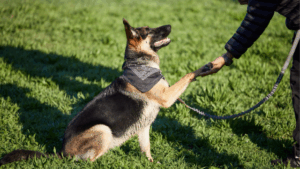When people imagine becoming a dog trainer, they often picture hands-on work—teaching dogs to sit, stay, and walk calmly on a lead. While these practical skills are essential, they’re only one part of what it takes to be a truly effective dog trainer. Behind every confident leash correction or timely reward lies a deep understanding of how dogs think, learn, and respond to the world around them. That understanding comes from theory.
Learning the theory first sets the foundation for all practical work that follows. It ensures trainers aren’t simply copying techniques they’ve seen elsewhere but are applying methods grounded in proven science. With theory comes the ability to interpret behaviour, adapt approaches to individual dogs, and make training meaningful, ethical, and effective. In short, theory is what transforms training from a series of tricks into professional practice.

Building a Foundation Based on Science
Modern dog training is guided by principles rooted in behavioural science. Understanding concepts such as classical conditioning, operant conditioning, reinforcement schedules, motivation, and learning thresholds allows trainers to make sense of why dogs behave the way they do. It also helps them choose the right techniques to influence behaviour positively and humanely.
By starting with the science, students gain a clearer picture of how learning actually works in dogs. They learn to read canine body language, recognise signs of stress, understand the importance of timing, and apply reinforcement in ways that make sense to the animal. This knowledge forms the blueprint that informs every training decision, creating a thoughtful, skilled, and adaptable trainer.
Preventing Mistakes That Can Set Dogs Back
One of the most common mistakes among new trainers is unintentionally reinforcing the wrong behaviour or using methods that cause confusion or fear. Without understanding the theory behind learning, a well-meaning trainer might punish a dog for being scared, or reward an unwanted behaviour without realising it. These kinds of errors can delay progress, damage trust, and even create long-term behavioural issues.
With a strong theoretical base, these mistakes are far less likely. Trainers learn how to read a dog’s emotional state, avoid miscommunication, and use clear signals to support learning. They also understand how to prevent overexposure to stressors and how to use counter-conditioning when working with fearful or reactive dogs. The result is more effective, compassionate training and a better experience for both dog and handler.
Empowering Confident, Informed Decision-Making
Dogs are individuals with their own personalities, histories, and learning styles. What works for one dog may not work for another—and this is where theory becomes a vital tool. Trainers who understand behavioural principles can adjust their strategies, troubleshoot problems, and confidently respond to unexpected challenges without defaulting to outdated or forceful techniques.
This kind of adaptability comes from deep knowledge, not from memorising routines. When trainers know the why behind the how, they can think critically and make decisions that are not only effective but ethically sound. It’s what distinguishes a true professional from someone who simply repeats what they’ve seen without understanding it.

Supporting Communication with Clients
Dog trainers don’t work in isolation—they work with people. In fact, much of a trainer’s success depends on their ability to guide and educate pet owners. A solid grounding in theory allows trainers to explain behaviour and training methods clearly, helping clients understand their dog’s actions and feel confident about how to respond.
This kind of education is key to ensuring that progress continues at home. When owners understand the learning process and their dog’s needs, they’re more likely to stay consistent, patient, and motivated. Trainers who can communicate theory effectively not only get better results but also build stronger relationships with clients built on trust and professionalism.
Practical Skills Mean More When Theory Comes First
There’s no doubt that hands-on practice is essential. But without the theory to back it up, practical training can become mechanical or inconsistent. When students approach practical tasks with a strong theoretical framework, they understand why timing matters, why a certain tool is used, or why a dog might suddenly disengage or act out.
This depth of understanding elevates the quality of training. It allows students to be more observant, more precise, and more effective in their application of skills. Instead of simply repeating actions, they are reading behaviour, adapting to feedback, and refining their techniques in real time—all because they understand the science behind what they’re doing.
At Dog Trainer Academy, we believe the best trainers are those who combine knowledge with compassion, technique with understanding. That’s why our ACM40322 Certificate IV in Animal Behaviour and Training begins with a strong theoretical foundation before moving into practical skill development. When you understand the why, you’re better prepared to succeed in the how—and make a lasting impact on the lives of dogs and their humans.
Ready to start your journey as a professional dog trainer? [Click here to explore the course and enrol today.]
